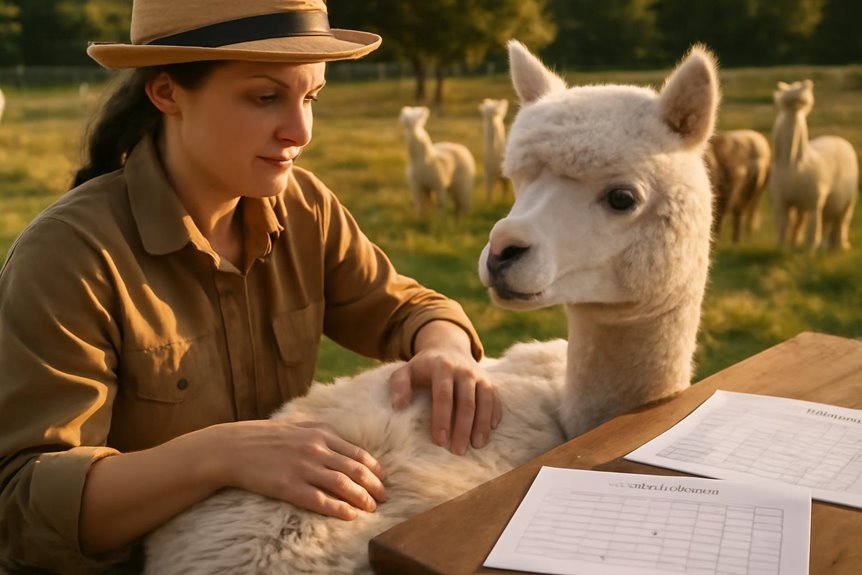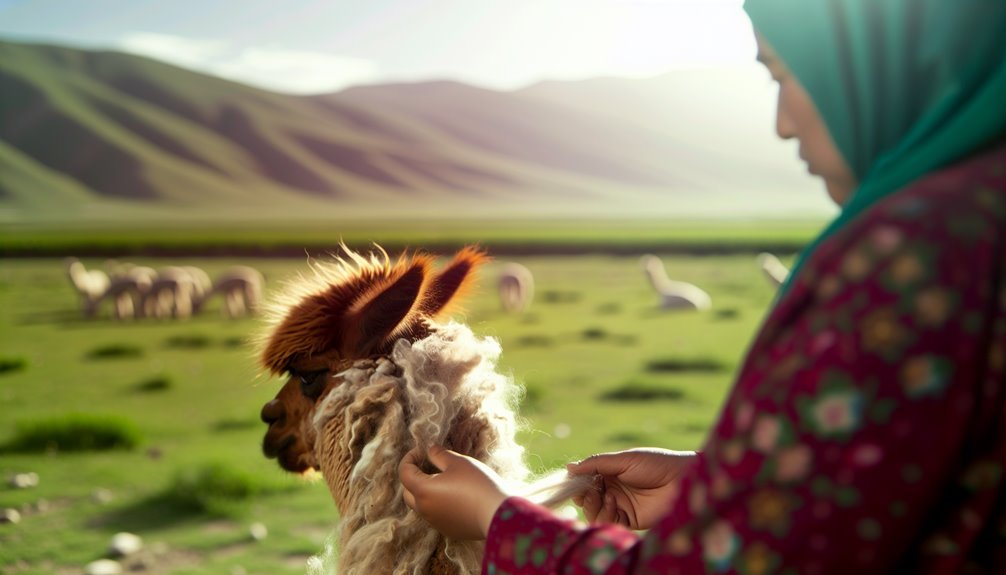3 Best Practices for Alpaca Selective Breeding
To boost your alpaca breeding success, first focus on evaluating genetic traits and lineage to choose animals with superior fleece and strong pedigrees. Next, strategically pair males and females with complementary qualities while maintaining genetic diversity to avoid inbreeding. Finally, guarantee pregnant females get balanced nutrition and proper care throughout gestation to support healthy birthing and offspring development. Following these steps sets a solid foundation for improving your herd’s quality and longevity, with more detailed strategies available to explore.
Key Takeaways
- Focus on selecting breeding alpacas with superior fleece quality, including fineness, density, and uniformity.
- Utilize genetic records and Expected Progeny Differences (EPDs) to predict and enhance desirable offspring traits.
- Prioritize genetic diversity by introducing outside studs and avoiding close inbreeding to maintain herd health.
- Provide pregnant females with balanced nutrition, emphasizing protein, minerals, and hydration for optimal gestation outcomes.
- Incorporate genetic testing to anticipate offspring colors and improve breeding decisions based on heritable traits.
Assessing Genetic Traits and Lineage

When you’re evaluating genetic traits and lineage in alpaca breeding, focusing on fleece quality—like fineness, density, and uniformity—is key to producing superior offspring. You’ll want to start by appraising genetic traits using available lineage data from genetic records, such as those maintained by the Alpaca Owners Association. These records help track desirable traits and support informed breeding choices. Expected Progeny Differences (EPDs) provide valuable predictions on trait inheritance, guiding you to select animals that improve your herd’s genetic quality. Incorporating genetic testing, including color genotyping, allows you to anticipate offspring color outcomes and optimize your breeding strategy. Understanding the heritability of traits—typically around 30% in alpacas—helps you make effective choices that enhance fleece characteristics and overall herd performance.
Strategic Pairing and Genetic Diversity
Building on your understanding of genetic traits and lineage, strategic pairing is the next step to boost your herd’s quality. By selecting breeding males and female alpacas with complementary traits—like low micron count and high fleece density—you enhance fleece quality and overall herd value. Incorporating Expected Progeny Differences (EPDs) helps predict offspring traits, aligning your breeding program with desired outcomes. Prioritizing genetic diversity is essential; introducing outside studs reduces inbreeding risks, improving fertility and herd resilience. This diversity not only strengthens health but also broadens the gene pool, preventing genetic bottlenecks. Thoughtful strategic pairing guarantees you maintain both superior fleece characteristics and a robust, adaptable herd, setting your breeding program up for long-term success.
Ensuring Health and Nutrition During Gestation
Because gestation places increased demands on a female alpaca’s body, you need to provide a balanced, nutrient-rich diet to support both fetal growth and the dam’s health. Pregnant females require higher protein and calories, so offering high-quality hay alongside camelid-specific mineral supplements is essential for peak nutrition. Regularly monitoring body condition scores helps you maintain pregnant females within the ideal 3.0 to 3.5 range, ensuring they’re neither underweight nor overweight. Hydration is equally important; constant access to clean, cool water supports both metabolic needs and healthy fetal development. Gestation lasts about 11.5 months, and careful attention to health and nutrition throughout this period directly impacts the success of the birthing process and the cria’s health. Prioritize these practices for the best outcomes.
Frequently Asked Questions
At What Age Should You Stop Breeding Alpacas?
You shouldn’t stop breeding alpacas solely by age; consider female fertility, male maturity, and reproductive lifespan. Monitor health, breeding frequency, and pregnancy duration. Keep detailed breeding records to balance genetic diversity and manage weaning age effectively.
What Is the Mating Ritual of Alpacas?
You’ll find alpacas’ mating behaviors fascinating—females show receptivity by “cushing,” while males use breeding calls and courtship displays to assert dominance. These social interactions shape herd dynamics throughout mating seasons and influence reproductive health during gestation periods.
How to Get Alpacas to Mate?
You’ll use mating techniques like halter or pasture breeding, monitor female receptivity during breeding cycles, guarantee male dominance, manage stress, consider health and environmental factors, track genetic compatibility, keep breeding records, and make careful mating observations.
Can You Keep Male and Female Alpacas Together?
You shouldn’t keep males and females together year-round due to male aggression and breeding cycles. Separate them to manage breeding compatibility, space requirements, and health considerations while monitoring female behavior, social interactions, herd dynamics, feeding habits, and environmental factors.







Our picks
Alpaca & Wool Felted Sole Inserts: Comfy Upgrade?
Best Alpaca Socks for Hiking: Ultimate Comfort and Durability on Trails
Best Alpaca Halter for Comfort and Control